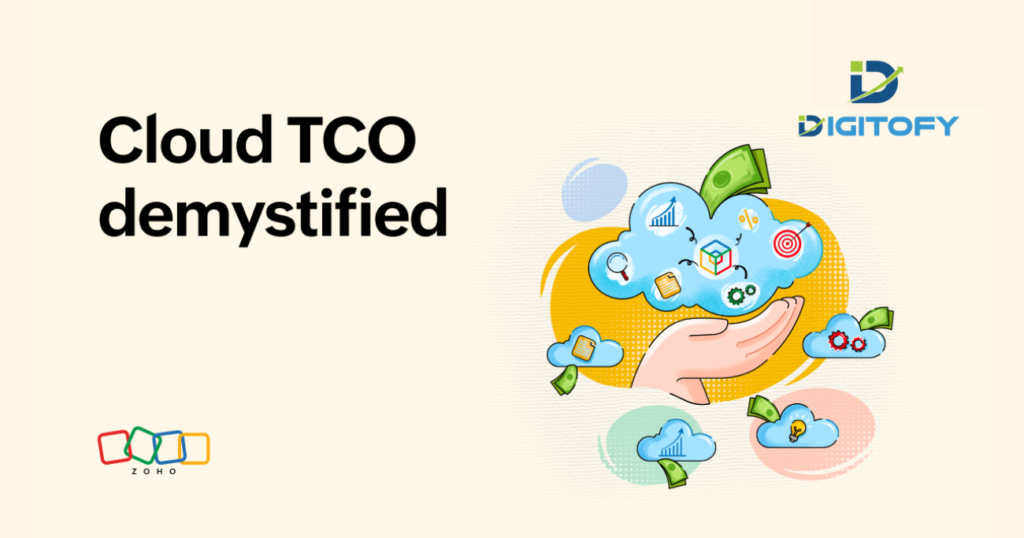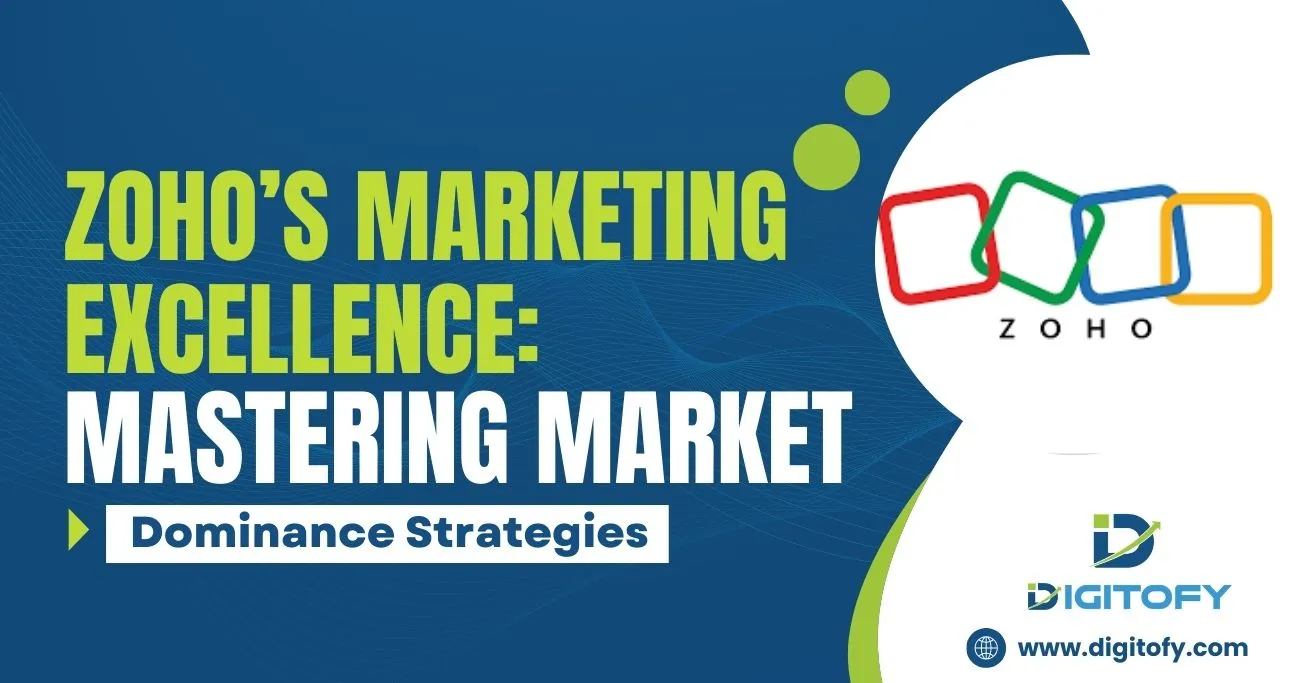Uncovering Zoho’s Successful Marketing Strategy that Made Sridhar Vembu 2700+ Crores Profit
Introduction
In the dynamic landscape of technology, where giants like Microsoft and Salesforce reign supreme, Zoho Corporation has emerged as a formidable player, carving its path to success. Founded in 1996 by Sridhar Vembu and Tony Thomas in India, Zoho has grown exponentially over the past two decades, becoming one of the most successful Software as a Service (SaaS) companies globally, with a staggering 100+ million users worldwide. In this blog, we’ll take a deep dive into Zoho’s comprehensive marketing strategy, exploring the key elements that have propelled it to the forefront of the industry.
About Zoho: From Humble Beginnings to Global Powerhouse
Stemming from a humble apartment in 1990s Chennai, Sridhar Vembu and Tony Thomas sought to “build smart technology helping businesses work better.” This vision manifests today as Zoho Corporation – a global technology powerhouse offering 55+ apps empowering organizations to enhance productivity and unlock their potential. Trusted by over 100+ million users, Zoho’s innovative tools streamline operations across sales, marketing, HR, finance, and more.
Over the years, Zoho has bootstrapped its growth, relying on internal funding and profits to scale up. This has allowed the company to stay private and focus on long-term success rather than getting distracted by quarterly public market pressures. Zoho’s founder and CEO, Sridhar Vembu, holds over 50% ownership in the company.
2020 Zoho was valued at over $8 billion in private markets. It reported revenue of $800 million in 2021, an impressive 100% increase from $400 million in 2020. Zoho is currently believed to be growing between 40-50% year-on-year.
Also, Watch Our YouTube Shorts Video on Day-I Uncovering Zoho’s Successful Marketing Strategy that Made Sridhar Vembu 2700+ Crores Profit.
Zoho’s Marketing Blueprint: Unveiling Success
Zoho’s path to dominance is illuminated by a meticulously crafted marketing blueprint, a fusion of strategic components driving unparalleled success.
Multi-Faceted Strategy Unveiled
Zoho’s marketing arsenal is a versatile toolkit encompassing various strategic elements. From innovative product offerings to customer-centric pricing, broad platform accessibility, strategic partnerships, and influencer marketing, each facet plays a crucial role in the grand symphony of Zoho’s marketing approach.
Focus on Excellence
At the core of Zoho’s marketing strategy lies an unwavering focus on excellence. The company places a premium on product innovation, constantly pushing the boundaries to offer solutions that redefine industry standards. Customer-centric pricing ensures accessibility without compromising on quality, making Zoho’s suite of products a compelling choice.
Broad platform access further extends Zoho’s reach, allowing businesses of all sizes to benefit from its comprehensive suite. Strategic partnerships amplify Zoho’s impact, creating synergies that contribute to the brand’s rapid global growth. The inclusion of influencer marketing adds a human touch, fostering trust and credibility in the ever-evolving landscape.

Objective: Lighting the Path to Global Growth
Zoho’s marketing blueprint is strategically designed to propel the company towards a singular objective—rapid global growth. Every element, from innovation to partnerships, aligns with this overarching goal. Zoho doesn’t just aim for dominance in specific markets; it envisions a global footprint, reaching businesses and users across continents.
In essence, Zoho’s marketing blueprint is a dynamic framework that combines innovation, customer-centricity, collaboration, and influential partnerships, all working harmoniously to drive the company’s relentless pursuit of global market dominance.
Also Read: Hooking The Credit-Worthy: How CRED Mastered Exclusivity Marketing
Zoho’s Impressive Product Portfolio
In the ever-evolving realm of technology solutions, Zoho stands tall with a comprehensive suite of tools designed to propel businesses forward.
At the heart of Zoho’s prowess lies a versatile portfolio comprising more than 55 cloud-based business applications. This expansive toolkit caters to a myriad of organizational needs, offering a holistic solution for businesses navigating the digital landscape. Whether it’s streamlining customer relations, orchestrating email marketing campaigns, or collaborating seamlessly on online documents, Zoho’s arsenal covers it all.
Zoho takes pride in breaking down barriers to entry. With a keen emphasis on affordability, Zoho’s suite is engineered to empower organisations of all sizes. The belief in providing robust tools without exorbitant price tags underscores Zoho’s commitment to democratising access to cutting-edge solutions. It’s a philosophy that echoes in every facet of their offerings – powerful yet accessible.
Zoho’s impact resonates across critical sectors, proving its versatility in addressing diverse business requirements. From Customer Relationship Management (CRM) that forms the bedrock of client interactions to the intricacies of email marketing that drive engagement and the collaborative efficiency of online documents – Zoho’s solutions seamlessly integrate into various business functions. This strategic coverage ensures organizations can rely on Zoho as a one-stop destination for their multifaceted needs.
In essence, Zoho’s product portfolio is not just an assortment of applications; it’s a tailored toolkit designed to empower businesses with affordability, power, and a holistic approach that transcends industry boundaries.
Also Read: Bringing Convenience And Care To Your Doorstep: The Marketing Strategies Behind PharmEasy’s Success
Multi-Pronged Marketing Strategy
Zoho’s marketing strategy is a well-crafted symphony of innovation, customer-centricity, strategic partnerships, and influencer engagement. The company leverages product innovation, customer-centric pricing, broad platform access, and strategic partnerships to drive rapid global growth. Let’s unravel the layers of Zoho’s marketing prowess.
Recent Development
Zoho continues to innovate and expand its product portfolio rapidly. Over the past year, the company has added several new solutions:
- Zoho Workplace: An integrated suite of collaboration and productivity tools, including email, video conferencing, online documents, and cloud storage.
- Zoho BackToWork: A comprehensive return-to-work solution covering contact tracing, shift management, workplace communication, and employee wellness tracking.
- Zoho Commerce: An e-commerce platform optimised for B2B transactions, wholesale, and subscriptions.
- Zoho Recruit: A full-featured applicant tracking system designed for modern recruiting teams.
Zoho continues to expand globally, tailoring its marketing, product localisation, and partnerships for growth markets like Latin America, the Middle East, and Southeast Asia.

Buyer Persona
Zoho targets two primary buyer personas with its marketing strategy:
1. SMB Owners / Managers
These are typically the primary decision-makers in small companies. As business owners focused on growth and productivity, they care about value, integration, ease of use, and flexibility. Many come from non-tech backgrounds, so user-friendliness is essential.
2. Mid-Market IT Leaders
In mid-size companies, Zoho targets managers and executives in IT, operations, and finance. With experience selecting and implementing business systems, they focus on security, reporting, API access, and overall capability relative to cost.
In both cases, Zoho positions itself as an affordable yet powerful all-in-one suite that can match and even exceed the individual products of niche competitors. It highlights the cost and convenience benefits of consolidating systems on one integrated platform.
Also Read: How DS Group Made History By Selling 100 Crore Pulse Candies In 8 Months
Zoho’s Key Marketing Principles
Zoho employs an innovative marketing mix centred around four key elements – product, pricing, placement, and promotion.
1. Product Strategy
With over 55+ enterprise SaaS apps covering front and back-office functionality, Zoho has one of the market’s broadest product portfolios. New products are added almost every quarter based on filling gaps in the portfolio or identifying fast-growing segment opportunities.
While specs are not necessarily best-in-class for every solution, Zoho’s products are designed to provide 80% of the functionality at 30% of the price. Frequent updates also incorporate customer feedback to evolve the products continuously.
By integrating its toolkit into a unified operating system, Zoho creates inherent customer stickiness. Once a company adopts multiple Zoho products and builds custom workflows, migrating data and processes to new platforms becomes exceptionally costly.
Zoho also offers free product editions with limited users/features but enough capability to demonstrate value. This helps turn new users into paying customers for more advanced functionality.
2. Pricing Strategy
Central to Zoho’s positioning is its affordable and transparent pricing. Every product lists detailed pricing tables on its website, with all features and capabilities included for that price.
Most products start with a free version, then scale up based on the number of users, features, storage space, and customer support needs – making them scalable for companies of any size.
Zoho publishes guaranteed price increases for the next five years on its website to enable customers to forecast software costs accurately. Pricing is also standardised globally without surprises. Custom pricing or negotiation is not entertained to provide an equitable platform to organisations everywhere.
This transparent and predictable pricing helps build trust and positions Zoho enormously on value relative to complex pricing from competitors. Zoho also usually comes in 70-80% cheaper than competing platforms.
3. Place Strategy
With a 100% web-based SaaS suite, Zoho makes its products easily accessible worldwide. This allows the company to pursue global growth and leverage network effects for user growth and product feedback.
Zoho offers native language interfaces in over 25 languages, including Spanish, Chinese, Arabic, German, Hindi, and more. This helps overcome adoption barriers in international markets.
Partnerships with technology marketplaces like Google Cloud, AWS, and Microsoft Azure increase discoverability for Zoho’s apps among new businesses selecting cloud-based staples.
Zoho also cultivates an ecosystem of implementation partners globally to facilitate onboarding, especially for larger corporate clients with complex requirements.
4. Promotions Strategy
Zoho executes a multifaceted promotions strategy encompassing online advertising, conferences, integrations, community building, and influencer engagement.
PPC ads help attract visitors searching for related apps to its website, and then free trials convert prospects. Zoho also hosts Zoholic user conferences globally to demo new products and have experts showcase Zoho-powered solutions.
Hundreds of integrations with platforms like Mailchimp, Zapier, and Hubspot broaden accessibility and complementary capabilities for Zoho’s suite.
Active social media engagement and forums foster a strong user community that provides authentic peer validation, referrals, and product feedback.
Lastly, collaborations with influential figures like Anil Dash and Guy Kawasaki help spur viral, word-of-mouth growth among technophiles.
Also Read: The Art Of Premium Style: Unraveling Monte Carlo’s Marketing Magic
Zoho Competitor Analysis
Zoho competes against some of the world’s most prominent enterprise technology vendors who dominate segments of business software:
1. Salesforce: The world’s #1 leader in CRM software and a pioneer of cloud-based apps for business, Salesforce offers multiple sales, marketing, and customer service solutions. With revenue over $17 billion, it is significantly larger than Zoho but mainly caters to large enterprises.
2. Microsoft: A global super-brand, Microsoft competes across Zoho’s entire suite, covering email, documents, spreadsheets, BI, and more. However, its offerings tend to be desktop-centric, requiring Microsoft servers and infrastructure and creating lock-in.
Overall, Zoho competes favourably on pricing and focus while matching core functionality. Its independent developer ecosystem also provides greater flexibility. By integrating multiple engines into a unified OS for business, Zoho reduces the need for separate vendors.
Also Read: Cracking Open The Crunch: Kurkure’s Winning Marketing Mix
Zoho’s Marketing Approach
Zoho employs an innovative marketing approach to drive global awareness and adoption of its solutions. Let’s analyse six core aspects of its strategy:
1. The Freemium Technique
A key element of Zoho’s customer acquisition and retention has been its pioneering ‘Freemium’ strategy across its products. Most Zoho solutions have a free version with limited users and features but enough to demonstrate the value proposition.
Users often onboard via these free editions, experience the products, integrate them into workflows, and accumulate data/customisations. Over time, increasing dependency on Zoho tools within business systems leads users to subscribe to paid versions for additional capability, storage, and support. Viral adoption and referrals further accelerate this ‘Land & Expand’ user journey.
The Freemium model lowers barriers to adoption while allowing virality, referrals, and proven technology to convert free users to long-term paying customers. It embodies Zoho’s product-led approach of letting solutions sell themselves based on their merits.
2. Product-Led Growth
At its core, Zoho believes its superior products will stand out in terms of user experience and capabilities. By offering free editions packed with value, the products are designed to be self-propelling – almost every solution generates hundreds of positive online reviews.
3. Word of Mouth & Referrals
Over 60 million users create a powerful referral effect, as happy customers showcase Zoho’s cost and functionality benefits to peers. Zoho fuels this by enabling free trials for referred prospects. Its standalone tools also integrate across websites, serving as lead magnets to the broader suite.
4. Online Advertising
PPC and retargeting help Zoho engage buyers who are actively searching for relevant apps. This allows capturing demand from high-intent prospects already aware of the problem but still trying to figure out the best solution. Zoho targets keyword searchers for category leaders.
5. Content & Community
Zoho creates tremendous online content, including eBooks, tools, videos, and guides to attract visitors. SEO and content drive up to 40% of traffic. Its forums, blogs, and social channels also foster vocal user communities that drive advocacy and feedback.
6. Technology Partnerships
Third-party integrations are critical for adoption, as partnerships with platforms like Shopify, Mailchimp, and Hubspot significantly increase accessibility. Zoho also lists on app marketplaces of AWS, Azure, Google Cloud, and others to tap new SaaS users.
6. Influencer Marketing
Aligning with respected industry experts like Anil Dash and Guy Kawasaki provides validation. These key opinion leaders (KOLs) highlight Zoho’s unique offering to millions of followers – catalysing viral, trust-based growth.
Also Read: Driving Entrepreneurship And Commerce With Meesho’s Innovative Marketing
Conclusion
In an industry long dominated by Microsoft, Salesforce, and other multinational incumbents, Zoho’s marketing strategy has allowed it to successfully compete head-on to become one of the world’s top enterprise SaaS companies with over 60 million users despite its underdog status.
Combining viral product-led growth fuelled by ‘Freemium’ adoption, strategic technology partnerships, transparent pricing, targeted promotions, and an obsessive focus on customer experience, Zoho has built a category-leading portfolio of apps alongside a global user community evangelising its solutions.
And this may only be the start; as Zoho strengthens its traction across the Americas, Europe, and Asia, more organisations seem poised to adopt Zoho’s mantra of running their entire business on a unified technology stack that boosts productivity while lowering costs.
Related Blogs
- Achieving 15% Market & 8000+ Crore Revenue by “NEROLAC” with Disrupting Marketing Strategy
- ITC Unique Marketing Strategy That Made it into $80 Billion Group
- Frooti’s Unstoppable Marketing Strategy That Made Parle Biggest Beverage Leader in 2000’s
- MS Dhoni and Dream11: Unravellig the Marketing Strategy of Top Fantasy App of India
- How Peyush Bansal’s Marketing Strategies Made Lenskart The Most Lovable Brand?
- Groww : How 67,00,000 People Are Investing Through This Mobile App

.webp)

